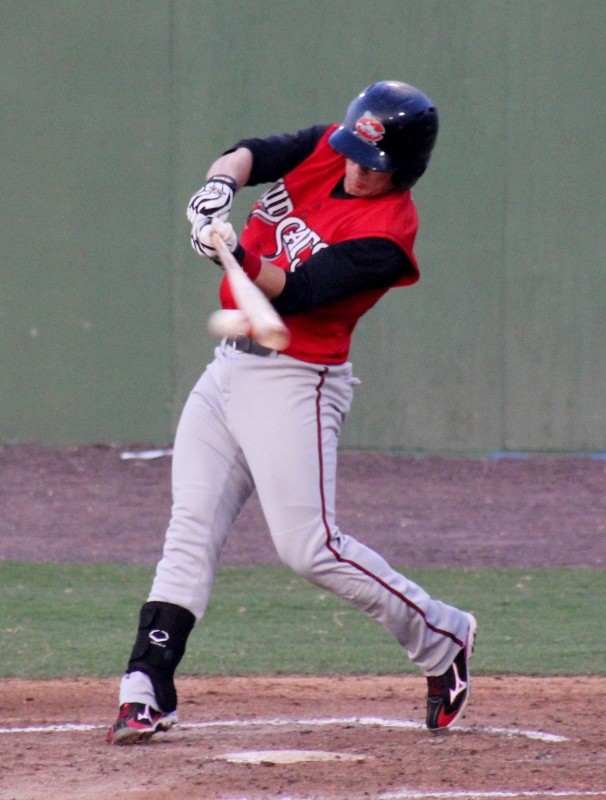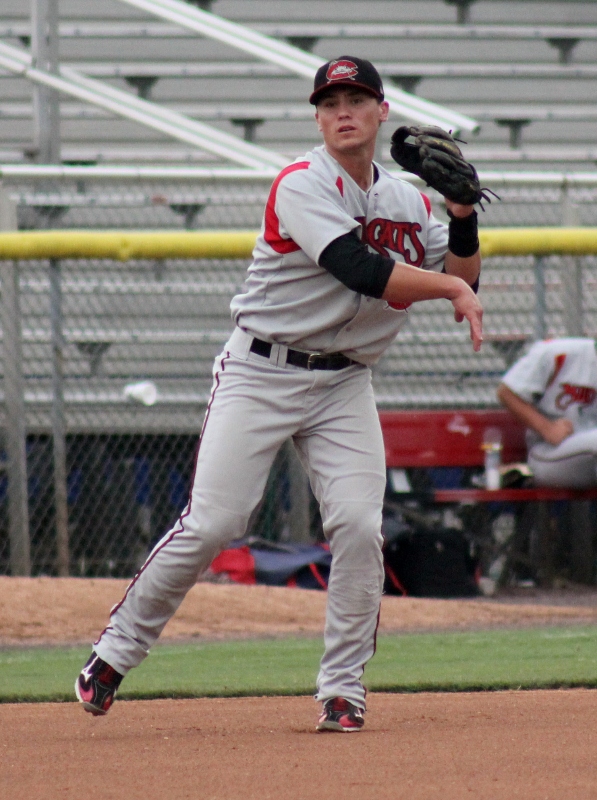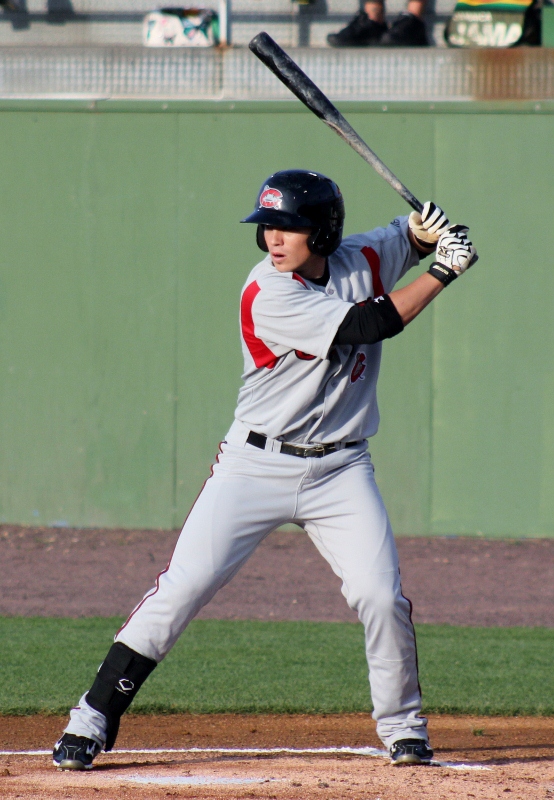 Indians Archive
Indians Archive  Slow Start, Big Finish for Tony Wolters in 2012
Slow Start, Big Finish for Tony Wolters in 2012
 With their third round pick in the 2010 MLB draft, the Indians selected shortstop Tony Wolters out of Rancho Buena Vista High School in California. Wolters signed late in the process, and reported to Arizona where he managed to get just 5 games in during the Rookie League that year. Expected to begin 2011 in Lake County, Wolters broke a bone in his hand during spring training and ended up missing the beginning of the year, so the Indians sent the 19-year old to short-season Mahoning Valley. Wolters hit .292/.385/.363 with a HR, 20 RBI, 50 runs scored and 19 stolen bases in 69 games for the Scrappers and seemed primed for a breakout in 2012. Based on his strong 2011 performance as well as the presence of 2011 first round draft pick Francisco Lindor in Lake County, the Indians decided to aggressively push Wolters straight to the high-A Carolina Mudcats for opening day 2012.
With their third round pick in the 2010 MLB draft, the Indians selected shortstop Tony Wolters out of Rancho Buena Vista High School in California. Wolters signed late in the process, and reported to Arizona where he managed to get just 5 games in during the Rookie League that year. Expected to begin 2011 in Lake County, Wolters broke a bone in his hand during spring training and ended up missing the beginning of the year, so the Indians sent the 19-year old to short-season Mahoning Valley. Wolters hit .292/.385/.363 with a HR, 20 RBI, 50 runs scored and 19 stolen bases in 69 games for the Scrappers and seemed primed for a breakout in 2012. Based on his strong 2011 performance as well as the presence of 2011 first round draft pick Francisco Lindor in Lake County, the Indians decided to aggressively push Wolters straight to the high-A Carolina Mudcats for opening day 2012.
To say that Wolters’ 2012 got off on the wrong foot would be an understatement. In 18 games during the month of April, the 19-year old hit just .130/.231/.159, managing just 9 hits in 69 at bats. Young players generally struggle to adjust from the short-season New York-Penn League to the low-A Midwest League. But to skip low-A altogether is an enormous challenge. It’s understandable that Wolters struggled to adjust to the better pitching in the Carolina League, especially the advanced secondary stuff that hitters start to see at that level. “The month of April was one of the longest months of my life,” said Wolters. “Each day felt like a month. But every day I learned something, I kept on learning and learning…I made some good decisions about my swing and they never gave up on me. That long month of April really helped out; I think it’s going to be one of the most important parts of my career.” That was Wolters looking back on his April when I caught up with him in August, so it was a lot easier for him go see that month as part of the learning process. Wolters rebounded to hit .291/.360/.408 in May on his way to a final line of .260/.320/.404 in 125 games for the Mudcats. While April was a rough month, it really did help him become a better player in the long run, both mentally and physically. “I knew I could get myself out of what I was doing in April. It was tough, there were nights where it was hard to go to sleep. I talked to my parents, prayed to God every night, but I knew I could get through it. You just have to step back and realize, you’re playing a kids game. You’re going to have those weeks, those months…every baseball player goes through that. You’re only going to get better, and I’m glad the Indians are pushing me to things I’m not used to in order to get better.”

That line isn’t overly impressive alone, but when you consider his age (turned 20 in June), the fact that he was playing above-average defense at both SS and 2B, and the hole that he had to climb out of after his poor April, you realize that Wolters’ season cannot be summed up just from looking at his triple-slash line. He was 8th in the league with 30 doubles, led the league with 8 triples, and even managed to finish in the top-20 in the league with his .724 OPS. Oh, and he was the youngest player on the Mudcats roster. Wolters had a steep learning curve to deal with in the Carolina League, and after April he not only survived, but thrived in a league notorious for being one of the toughest offensive environments in minor league baseball. His season peaked with an extremely impressive month of July, when he hit .343/.396/.505 with a pair of HR in 25 games.
Wolters was given high marks for his work ethic and intangibles prior to the draft, and that scouting report has held true for the infielder as a professional as well. Wolters is one of the hardest working players in the organization, and a guy that leads by example on and off the field. I had an opportunity to watch Wolters’ pre-game routine before a mid-August game in Potomac, and came away impressed. To start, Wolters takes a round of BP with his group. He then moves out to either 2B or SS and takes a round of grounders from one of the coaches while the 2nd group hits. When the third group is in the cage, Wolters stays out in the field and takes grounders from whoever is hitting. After that, when everyone else heads into the clubhouse to rest and grab a bite before the game, Wolters had manager Edwin Rodriguez hit him grounders while he’s on his knees to improve his hands and his reaction time. Again, this is all before the game even begins.
Wolters was primarily a SS in high school and then in his first professional season in Mahoning Valley, but was asked to play 2B last year to increase his versatility and value to the organization. I asked him about switching back and forth between two pretty demanding defensive positions, and Wolters said “For me, 2B is a hard position. The angles are so much different, you have to like the cut of the grass and be able to take balls off the grass, and that’s something I’m not used to yet. At 2B, you’re using your backhand a lot more than at SS. It’s a different rhythm, and I’m still getting used to it, but I’m making progress. Give me this offseason, and I’ll be completely fine with it.” He made 16 errors in 63 games at 2B, and just 8 errors in 61 games at SS. He’s clearly more comfortable at SS, but with the amount of talent the Indians have at that position in the minors they really need Wolters to be able to play both middle infield positions going forward.

I talked to Wolters about the adjustments he made in the Carolina League, and also about how the league adjusted to him once he started hitting. One thing he really noticed was that he was seeing fewer and fewer fastballs and more and more breaking balls. “If you miss a fastball, that’s the last fastball you’re going to see. You see pitchers almost twice a week sometimes, so they learn how to get you out pretty quickly. You just have to be able to recognize mistakes and make them pay for those mistakes.” By the end of the season, the left-handed hitting Wolters actually ended up hitting for a higher average (.264) off of lefties than righties (.259). That’s a pretty remarkable achievement for a kid his age and experience level. He didn’t make any huge mechanical changes, but really worked to start his swing earlier and softer to help stay back on breaking pitches. Every at bat was a learning experience, and Wolters’ never-ending desire to improve helped him to become a much better baseball player in September than he was in April.
The Indians farm system is loaded with middle infield prospects right now. Francisco Lindor, Ronny Rodriguez, Dorssys Paulino and Wolters will all be top-10 prospects in the organization this offseason. All four of them will start the 2013 season prior to their 21st birthdays. While the Indians system as a whole is down right now, that up the middle talent represents a chance for the system to work its way back in a hurry, as those guys all have the potential to be solid major leaguers (or more) down the road. Whether he ends up at shortstop or 2B long-term, Wolters is going to be an important part of this organization. He’s a talented defender with the ability to hit at the top of a batting order, and really has off the charts makeup and intangibles. If Wolters doesn’t have a successful major league career, it will definitely not be for lack of effort on his part. He’s one of my favorite players in the organization, a lot of fun to watch on the field, and will be a joy for AA Akron fans next season.
- NBA Announces 2013-2014 Schedule
- Browns Ink Sharknado
- Sharknado A No-Show For Rookie Camp
- Trent Richardson Out Until Training Camp
- Browns Sign Brandon Jackson
- Carrasco Suspended Eight Games
- Browns Add to Wide Receiver Depth with David Nelson
- Browns Need to Learn from Past Draft Mistakes
- Browns Release Chris Gocong and Usama Young
- Browns Missing on Grimes Disappointing, But Not The End
The TCF Forums
- Chris Grant's first 3 drafts
Kingpin74 (Tuesday, January 21 2014 10:13 AM) - The 2014 Offseason Thread
googleeph2 (Tuesday, January 21 2014 9:36 AM) - 2015 Recruiting
furls (Tuesday, January 21 2014 6:57 AM) - Mike Brown
YahooFanChicago (Monday, January 20 2014 11:15 PM) - Movies coming out
HoodooMan (Monday, January 20 2014 9:34 PM) - 2014 Hoops Hockey Hijinx
jpd1224 (Monday, January 20 2014 4:44 PM) - 2014 Recruiting
jclvd_23 (Monday, January 20 2014 2:26 PM) - Wish List - #4 Pick
Hikohadon (Monday, January 20 2014 1:26 PM) - Official- Browns Coach Search/Rumors
OldDawg (Sunday, January 19 2014 6:48 PM) - #1 overall pick Anthony Bennett
TouchEmAllTime (Sunday, January 19 2014 1:28 PM)


